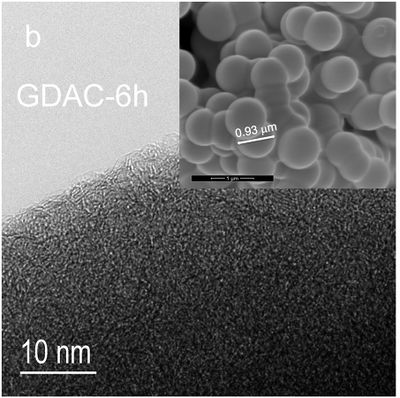Hydrothermal Carbonization: Difference between revisions
Jump to navigation
Jump to search

(Added some more information) |
(Moved some stuff around) |
||
| Line 1: | Line 1: | ||
[[Image:Hydrothermal Carbonization01.jpg|400px|thumb|right| Carbon nanoballs made from glucose via hydrothermal carbonization, that have been processed with CO<sub>2</sub> for 6 hours to change surface properties. SEM image from [https://en.wikipedia.org/wiki/University_of_Tartu University of Tartu].]] | [[Image:Hydrothermal Carbonization01.jpg|400px|thumb|right| Carbon nanoballs made from glucose via hydrothermal carbonization, that have been processed with CO<sub>2</sub> for 6 hours to change surface properties. SEM image from [https://en.wikipedia.org/wiki/University_of_Tartu University of Tartu].]] | ||
=Basics= | =Basics= | ||
| Line 8: | Line 6: | ||
*The resulting "biocoal" can be used as a [[Fuel]] or Chemical Feedstock, as a [[Soil Amendment]] (similar to [[biochar]]), and as a filtration media, among other things | *The resulting "biocoal" can be used as a [[Fuel]] or Chemical Feedstock, as a [[Soil Amendment]] (similar to [[biochar]]), and as a filtration media, among other things | ||
*’’’As with how [[Torrefaction]] is essentially partial [[Pyrolysis]] caused by calmer reaction conditions, HTC can be “tuned” to produce Pure Carbon, or something more akin to [[Lignite]] | *’’’As with how [[Torrefaction]] is essentially partial [[Pyrolysis]] caused by calmer reaction conditions, HTC can be “tuned” to produce Pure Carbon, or something more akin to [[Lignite]] | ||
=Open Source Hardware Needs= | =Open Source Hardware Needs= | ||
| Line 23: | Line 17: | ||
=External Links= | =External Links= | ||
* Paper: [http://www.sciencedirect.com/science/article/pii/S136403211500060X "A comparative review of biochar and hydrochar in terms of production, physico-chemical properties and applications"] | * Paper: [http://www.sciencedirect.com/science/article/pii/S136403211500060X "A comparative review of biochar and hydrochar in terms of production, physico-chemical properties and applications"] | ||
*[https://www.youtube.com/embed/CpPvZkDXr5g" | |||
[[Category:Biochar]] [[Category:Biofuel]] [[Category:Food and Agriculture]] | [[Category:Biochar]] [[Category:Biofuel]] [[Category:Food and Agriculture]] | ||
Revision as of 19:23, 16 September 2024

Carbon nanoballs made from glucose via hydrothermal carbonization, that have been processed with CO2 for 6 hours to change surface properties. SEM image from University of Tartu.
Basics
- Hydrothermal Carbonization (HTC), also known as "hydrochar", is a form of thermal biomass conversion that involves moderate temperatures and pressures over an aqueous solution of biomass in a dilute acid for several hours.
- One advantage of the HTC process over conventional dry-thermal pre-treatments is the ability to handle wet feedstock without pre-drying.
- The resulting "biocoal" can be used as a Fuel or Chemical Feedstock, as a Soil Amendment (similar to biochar), and as a filtration media, among other things
- ’’’As with how Torrefaction is essentially partial Pyrolysis caused by calmer reaction conditions, HTC can be “tuned” to produce Pure Carbon, or something more akin to Lignite
Open Source Hardware Needs
- Pressure Vessel
Internal Links
- Biochar (The term used for using Charcoal / Bio- Petcoke or Hydrochar in soil as a [[Soilsuch as Synthetic Amazonian Black Earth )
- Torrefaction
- The Biochar Economy